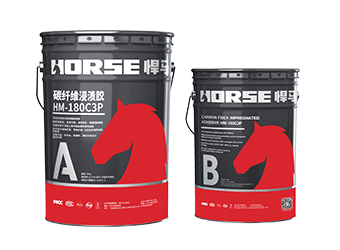Solutions
Horse Construction offers full range of structural strengthening materials with technical supports, documentation supports, products supports, project supports.
CFRP in strengthening concrete column

Project Overview
An office building in Xingtai City, Hebei Province has a length of 68 m, a width of 16 m, and a construction area of about 8,900 square meters. It has one basement level and seven floors above the ground. The structure is a frame structure and the foundation is a raft foundation. It was invested and constructed in 1980 and put into use the following year.
When it was renovated at the end of 2003, it was discovered that in the middle of the second and third floors of the building, there were three middle pillars with serious cracks at the roots of the pillars, serious spalling of concrete at the roots of the pillars, and rusted longitudinal bars of the pillars were clearly visible. After inspection and appraisal, it was found that the above three central pillars of the building had vertical cracks about 1 m away from the root of the pillars, the maximum crack width was 2.5 mm, and the main reinforcement and stirrups were heavily corroded. As a result, the effective area of the original stress bars is reduced, and the concrete at the roots falls off seriously, which has reduced the column section to varying degrees. In addition, several frame beams also showed serious cracks, and they all needed to be reinforced. This article only introduces reinforced columns.
Structural reinforcement method
At present, the common methods that can be used to strengthen reinforced concrete columns are the method of enlarging the column section, the method of wrapping steel, and the method of wrapping FRP materials. The encasing steel method is more effective than the reinforced concrete enlarged section method, because the enlarged section method increases the structural weight and section size. Both of these methods are labor intensive and on-site construction is sometimes difficult. In addition to the heavier steel, the outer steel sheath has poor resistance to harsh environmental erosion.
In recent years, the use of FRP materials (including CFRP, GFRP, AFRP, etc.) to reinforce reinforced concrete columns has become a new type of reinforcement method that replaces outer steel, and has been more and more widely used. The method has the advantages of high strength and high efficiency, convenient construction, good durability and corrosion resistance, thin thickness, light weight, etc. Among them, the most common form of FRP reinforced columns is outer fiber wrap or strips. This project chooses to outsource carbon fiber wrap to strengthen it.
There are several different techniques for strengthening reinforced concrete columns with FRP materials. According to the forming technique, the strengthening methods can be divided into three types: wet bonding method, continuous fiber winding method, and prefabricated shell method. The most commonly used method is the wet bonding method, which has outstanding advantages such as flexibility and ease of field operation. This case uses this method, using unidirectional fiber wrap infiltrated and pasted with resin on the surface of the column, so that the main fiber direction is along the circumferential direction of the column. The column can be completely wrapped by single or multi-layer fiber wrap, or can be partially wrapped by fiber wrap strips forming a continuous spiral hoop or spaced hoop. This project chooses carbon fiber wrap to be completely wrapped and reinforced.
The cross-sectional dimension of the rectangular column in this project is 500 mm×550 mm. Taking into account that the carbon fiber wrap hoop has a poor restraint effect on the rectangular column, it can provide a very effective restraint on the circular column. Therefore, the cross-sectional shape of the rectangular column in this project is first modified to an ellipse. Then use carbon fiber wrap hoop restraint, you can get better results. In this example, the quick-setting cement mortar is used to chamfer the rectangular column section, and then the section shape is changed to an ellipse
It needs to be wrapped and pasted with 3 layers of carbon fiber wrap, wrapped and pasted along the full height of the column, and each layer of carbon fiber wrap should be stitched and pasted in a staggered manner.
Conclusion
The reinforcement construction of the project was completed in September 2008. Since more than a year of use, there has been no abnormality in the CFRP reinforcement part. It shows that it is feasible to use carbon fiber wrap to wrap the surface of the concrete column to strengthen the reinforcement column. This method can be popularized and applied in actual projects.
You can find anything here you are in need of, have a trust trying on these products, you will find the big difference after that.

High strength, unidirectional carbon fiber wrap pre-saturated to form a carbon fiber reinforced polymer (CFRP) wrap used to strengthen structural concrete elements.

Good impregnation carbon fiber adhesive for applying carbon fiber reinforced polymer(CFRP) wrap for structural strengthening

High strength carbon fiber reinforced polymer (CFRP) strip / laminate / plate for structural strengthening and concrete repair